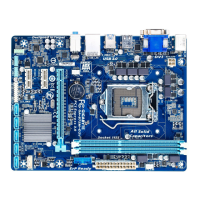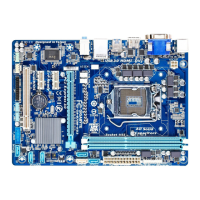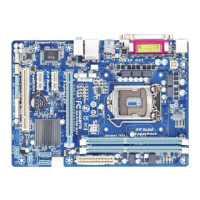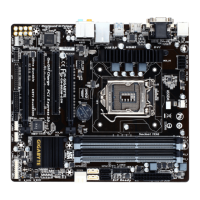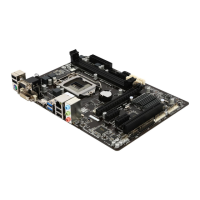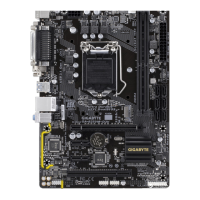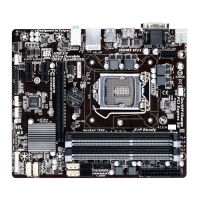Do you have a question about the Gigabyte GA-B75M-D3P and is the answer not in the manual?
Standard legal notices regarding the manual's content and usage.
Explains different types of documentation provided for the product.
Guide on how to find the motherboard's specific revision number.
Visual representation of the motherboard's components and connectors.
Diagram illustrating the functional blocks and data flow of the motherboard.
Essential safety and handling guidelines before installing hardware.
Detailed technical specifications of the motherboard's features and components.
Step-by-step instructions for installing the Central Processing Unit.
Guide on how to install RAM modules, including dual-channel configuration.
Instructions for installing add-in cards like graphics or sound cards.
Description of external ports and their functions on the motherboard's rear.
Details of internal headers and connectors on the motherboard for system components.
Overview of the initial screen displayed when the computer boots.
Introduction to the main BIOS setup interface and navigation.
Menu for configuring CPU and memory frequencies, voltages, and temperatures.
Settings related to system language, date, time, and access levels.
Configuration of boot order, virtualization, and other advanced system features.
Settings for onboard devices like SATA, USB, LAN, and audio controllers.
Options for controlling system power states and energy saving features.
Options for saving BIOS changes, exiting, or loading default settings.
Instructions on setting up SATA controllers and configuring RAID arrays.
Standard legal notices regarding the manual's content and usage.
Explains different types of documentation provided for the product.
Guide on how to find the motherboard's specific revision number.
Visual representation of the motherboard's components and connectors.
Diagram illustrating the functional blocks and data flow of the motherboard.
Essential safety and handling guidelines before installing hardware.
Detailed technical specifications of the motherboard's features and components.
Step-by-step instructions for installing the Central Processing Unit.
Guide on how to install RAM modules, including dual-channel configuration.
Instructions for installing add-in cards like graphics or sound cards.
Description of external ports and their functions on the motherboard's rear.
Details of internal headers and connectors on the motherboard for system components.
Overview of the initial screen displayed when the computer boots.
Introduction to the main BIOS setup interface and navigation.
Menu for configuring CPU and memory frequencies, voltages, and temperatures.
Settings related to system language, date, time, and access levels.
Configuration of boot order, virtualization, and other advanced system features.
Settings for onboard devices like SATA, USB, LAN, and audio controllers.
Options for controlling system power states and energy saving features.
Options for saving BIOS changes, exiting, or loading default settings.
Instructions on setting up SATA controllers and configuring RAID arrays.
| Non-ECC | Yes |
|---|---|
| Memory voltage | 1.5 V |
| Memory channels | Dual-channel |
| Memory slots type | DIMM |
| Number of memory slots | 4 |
| Supported memory types | DDR3-SDRAM |
| Maximum internal memory | 32 GB |
| Supported memory clock speeds | 1066, 1333, 1600 MHz |
| System bus rate | 5 GT/s |
| Processor socket | LGA 1155 (Socket H2) |
| Processor manufacturer | Intel |
| Compatible processor series | Intel Celeron, Intel Pentium |
| Maximum number of SMP processors | 1 |
| USB 2.0 connectors | 2 |
| Number of SATA II connectors | 5 |
| Number of SATA III connectors | 3 |
| Number of Parallel ATA connectors | - |
| USB 2.0 ports quantity | USB 2.0 ports have a data transmission speed of 480 Mbps, and are backwards compatible with USB 1.1 ports. You can connect all kinds of peripheral devices to them. |
| Audio chip | Realtek ALC887 |
| Cooling type | Passive |
| Component for | PC |
| Power source type | ATX |
| Motherboard chipset | Intel B75 |
| Audio output channels | 7.1 channels |
| Motherboard form factor | micro ATX |
| Compatible operating systems | Microsoft Windows 8/7/XP |
| RAID levels | 0, 1 |
| Supported storage drive interfaces | SATA II, SATA III |
| DirectX version | 11 |
| Maximum resolution | 2560 x 1600 pixels |
| Parallel processing technology support | 2-Way CrossFireX |
| PCI Express slots version | 2.0, 3.0 |
| PCI Express configurations | 1x1, 1x4, 1x16 |
| Controller 2nd interface type | Marvell 88SE9172 |
| Trial software | Norton Internet Security |
| Cables included | SATA |
| Bundled software | Intel Rapid Start Technology Intel Smart Connect Technology Intel Small Business Advantage |
| LAN controller | Realtek RTL8111DP |
| Ethernet interface type | Gigabit Ethernet |
| BIOS type | UEFI |
| ACPI version | 2.0a |
| BIOS memory size | 128 Mbit |
| Width | 244 mm |
|---|


